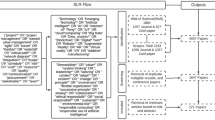Abstract
An operational-objective model of configurations of the organizational system corresponding to stable periods of its development is discussed. The forecast of dynamics of attaining the hierarchy of goals set before the system, dynamics of resource consuming, and dynamics of variation of system activity indices is the result of the analysis of the model. The model is based on the formalism of Petri nets and indicator logical functions. Hypothetical examples of extreme events that may lead to the change of configurations are represented.
Similar content being viewed by others
References
Novikov, D.A., Teoriya upravleniya organizatsionnymi sistemami: vvodnyi kurs (Theory of Organizational Structures Control: An Introduction), Moscow: MPSI, 2005.
Trakhtengerts, E.A., Subjectivity in Strategic Control, in Chelovecheskii faktor v upravlenii (Human Factory in Control), Moscow: Kom Kniga, 2006.
Mintzberg, H., Ahlstrand, B., and Lampel, J., Strategy Safari: A Guided Tour through the Wilds of Strategic Management, New York: Free Press, 1998. Translated under the title Shkoly strategii. Strategicheskoe safari: ekskursiya po debryam strategii menedzhmenta, St. Petersburg: Piter, 2000.
Grebenyuk, E.A., Logunov, M.G., Mamikonova, O.A., and Pankova, L.A., Subjectivity in Solving Problems of Control and Forecasting Related to the Analysis of Time Series, in Chelovecheskii faktor v upravlenii (Human Factory in Control), Moscow: Kom Kniga, 2006.
Kuznetsov, O.P., Kulinich, A.A., and Markovskii, A.V., Impact Analysis in Controlling Semistructured Situations Basing on Cognitive Maps, in Chelovecheskii faktor v upravlenii (Human Factory in Control), Moscow: Kom Kniga, 2006.
Quinn, J.B., Strategies for Change: Logical Incrementalism, Homewood: Irwin, 1980.
Peterson, J., Petri Net Theory and the Modeling of Systems, Upper Saddle River: Prentice Hall, 1981. Translated under the title Teoriya setei Petri i modelirovanie sistem, Moscow: Mir, 1984.
Kotov, V.E., Seti Petri (Petri Nets), Moscow: Nauka, 1984.
Vladislavlev, P.N., Muradyan, I.A., and Yuditskii, S.A., Objective and Operational Dynamic Models of Complex Processes: Their Interaction, Avtom. Telemekh., 2005, no. 11, pp. 126–134.
Yuditskii, S.A. and Magergut, V.Z., Logicheskoe upravlenie diskretnymi protsessami (Logical Control of Discrete Processes), Moscow: Mashinostroenie, 1987.
Author information
Authors and Affiliations
Additional information
Original Russian Text © S.A. Yuditskii, 2008, published in Avtomatika i Telemekhanika, 2008, No. 1, pp. 114–123.
Rights and permissions
About this article
Cite this article
Yuditskii, S.A. Operational-objective modeling of dynamics of organizational systems development via Petri nets. Autom Remote Control 69, 105–113 (2008). https://doi.org/10.1134/S0005117908010104
Received:
Published:
Issue Date:
DOI: https://doi.org/10.1134/S0005117908010104




